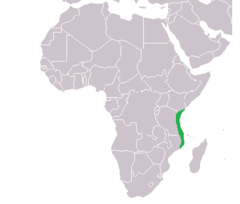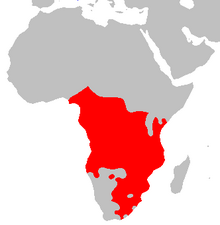ซันจญ์


ซันจญ์ (อาหรับ: زَنْج, คำคุณศัพท์: زنجي, ซันญี; จาก เปอร์เซีย: زنگ, อักษรโรมัน: Zang)[1][2] เป็นชื่อที่นักภูมิศาสตร์มุสลิมสมัยกลางใช้เรียกทั้งบริเวณแอฟริกาตะวันออกเฉียงใต้ (ส่วนใหญ่คือชายฝั่งสวาฮีลี) และผู้อยู่อาศัยชาวบันตู[3] ศัพท์นี้ยังเป็นต้นตอของชื่อสถานที่แซนซิบาร์ ("ชายฝั่งซันญี") กับทะเลซันจญ์
รูปแปลงภาษาละติน ซินกีนุม (Zingium) ทำหน้าที่เป็นชื่อเก่าของพื้นที่ชายฝั่งประเทศเคนยาและแทนซาเนียในปัจจุบันที่แอฟริกาตะวันออกเฉียงใต้ สถาปัตยกรรมของที่ตั้งถิ่นฐานในเมืองเชิงพาณิชย์เหล่านี้ในปัจจุบันเป็นหัวข้อการศึกษาสำหรับการผังเมือง[4][5] พื้นที่ชายฝั่งจากพื้นที่แนวหลังที่ถูกพิชิต จนถึงโลกมหาสมุทรอินเดียเป็นแหล่งที่มาของงาสัตว์ ทองคำ และทาสมาหลายศตวรรษ[6]
ศัพทมูลวิทยา[แก้]
ซันจญ์ ในภาษาอาหรับหมายถึง "ประเทศคนผิวดำ" คำทับศัพท์แบบอื่น ๆ ได้แก่ Zenj, Zinj และ Zang[7][8] Anthony Christie โต้แย้งว่าคำว่า zanj หรือ zang อาจไม่ได้มีต้นตอจากภาษาอาหรับ มีการบันทึกรูปภาษาจีน (
เป็นที่รู้กันว่ากลุ่มชนออสโตรนีเซียเดินทางมาถึงมาดากัสการ์ประมาณ ค.ศ. 50–500[11][12] เนื่องจากเส้นทางที่เป็นไปได้เส้นทางหนึ่งคือกลุ่มชนออสโตรนีเซียจากอินโดนีเซียเดินทางข้ามมหาสมุทรอินเดียโดยตรงจากเกาะชวาถึงเกาะมาดากัสการ์ มีแนวโน้มว่าพวกเขาเดินทางผ่านมัลดีฟส์ที่หลักฐานแบบแปลนเรืออินโดนีเซียเก่าและเทคโนโลยีการประมงยังคงอยู่จนถึงปัจจุบัน[13][9]: 32
การแบ่งชายฝั่งแอฟริกาตะวันออก[แก้]
นักภูมิศาสตร์ในอดีตแบ่งพื้นที่ชายฝั่งตะวันออกของแอฟริกาออกเป็นหลายภูมิภาคตามผู้อยู่อาศัยในแต่ละบริเวณ ข้อมูลอาหรับและจีนระบุถึงพื้นที่ทั่วไปที่ตั้งอยู่ทางใต้ของสามภูมิภาค ได้แก่ มิศร์ (อียิปต์), อัลฮะบะชะฮ์ (อะบิสซีเนีย) และบาร์บารา (โซมาเลีย) เป็น Zanj[14]
ซันจญ์ตั้งอยู่ในแอฟริกาตะวันออกเฉียงใต้และเป็นบริเวณที่มีกลุ่มชน Zanj ที่พูดภาษาบันตูอาศัยอยู่[3][14][15] พื้นที่หลักในการครอบครองของ Zanj ทอดยาวมาจากดินแดนทางใต้ของ Ras Kamboni ในปัจจุบัน[16]จนถึงเกาะเพมบาในแทนซาเนีย ทางใต้ของเพมบาคือที่ตั้งของซูฟาลาในบริเวณที่ปัจจุบันอยู่ในประเทศโมซัมบิก บริเวณที่ห่างไกลจากซูฟาลาคือดินแดนซ่อนเร้นวากวากที่อยู่ในโมซัมบิกเช่นกัน[17][18] อัลมัสอูดี นักประวัติศาสตร์และนักภูมิศาสตร์ชาวอาหรับในคริสต์ศตวรรษที่ 10 กล่าวถึงซูฟาลาเป็นขอบเขตที่ไกลที่สุดของชาว Zanj และกล่าวถึงตำแหน่งกษัตริย์ในบริเวณนั้นด้วยศัพท์ภาษาบันตูว่า Mfalme[3]
การกบฏซันจญ์[แก้]
การกบฏซันจญ์เป็นชุดการก่อกำเริบที่เกิดขึ้นในช่วง ค.ศ. 869 ถึง 883 ใกล้นครบัสราในประเทศอิรักในปัจจุบัน ชาวซันจญ์หลายคนถูกนำมาเป็นทาสทหาร แต่หลายคนได้รับอิสรภาพและเลือกที่จะอยู่ในอิรักในฐานะคนเสรีและทำให้อิรักเป็นบ้านของตนเองร่วมกับชาวอาหรับที่ลุ่ม[19]
M. A. Shaban อธิบายว่าการกบฏซันจญ์ไม่ใช่การก่อกบฏทาส แต่เป็นการก่อกบฏชาวอาหรับที่ได้รับการสนับสนุนจากผู้อพยพชาวแอฟริกาตะวันออกในอิรัก[20]
อ้างอิง[แก้]
- ↑ El-Azhari, Taef (2016). Zengi and the Muslim Response to the Crusades: The Politics of Jihad. Routledge. p. 20. ISBN 978-1317589396. สืบค้นเมื่อ 3 January 2017.
- ↑ Ḵẖān, M. S. (1981). "Al-Masʿūdī and the Geography of India". Zeitschrift der Deutschen Morgenländischen Gesellschaft. 131 (1): 119–136 [p. 130]. JSTOR 43376756.
- ↑ 3.0 3.1 3.2 Bagley, F. R. C.; และคณะ (1997). The Last Great Muslim Empires. Brill. p. 174. ISBN 1-55876-112-8.
- ↑ AlSayyad, Nezar (2001). Hybrid Urbanism: On the Identity Discourse and the Built Environment. Greenwood. p. 39. ISBN 0-275-96612-7.
- ↑ Pollard, E.; Fleisher, J.; Wynne-Jones, S. (2012). "Beyond the Stone Town: Maritime Architecture at Fourteenth–Fifteenth Century Songo Mnara, Tanzania". Journal of Maritime Archaeology. 7 (1): 43–62. Bibcode:2012JMarA...7...43P. doi:10.1007/s11457-012-9094-9. S2CID 162935843.
- ↑ Oliver, Roland (1975). Africa in the Iron Age: c.500 BC–1400 AD. Cambridge University Press. p. 192. ISBN 0-521-20598-0.
- ↑ Bagley, F. R. C.; และคณะ (1997). The Last Great Muslim Empires. Brill. p. 174. ISBN 1-55876-112-8.
- ↑ Raunig, Walter (2005). Afrikas Horn: Akten der Ersten Internationalen Littmann-Konferenz 2. bis 5. Mai 2002 in München. Otto Harrassowitz Verlag. p. 130. ISBN 3-447-05175-2.
ancient Arabic geography had quite a fixed pattern in listing the countries from the Red Sea to the Indian Ocean: These are al-Misr (Egypt)—al-Muqurra (or other designations for Nubian kingdoms)—Zanj (Azania, i.e. the country of the "blacks"). Correspondingly almost all these terms (or as I believe: all of them!) also appear in ancient and medieval Chinese geography
. - ↑ 9.0 9.1 Dick-Read, Robert (July 2006). "Indonesia and Africa: questioning the origins of some of Africa's most famous icons". The Journal for Transdisciplinary Research in Southern Africa. 2: 23–45. doi:10.4102/td.v2i1.307.
- ↑ Zoetmulder, P. J. (1982). Old Javanese-English dictionary. The Hague: Martinus Nijhoff. ISBN 9024761786.
- ↑ Dewar RE, Wright HT (1993). "The culture history of Madagascar". Journal of World Prehistory. 7 (4): 417–466. doi:10.1007/BF00997802. hdl:2027.42/45256. S2CID 21753825.
- ↑ Burney DA, Burney LP, Godfrey LR, Jungers WL, Goodman SM, Wright HT, Jull AJ (August 2004). "A chronology for late prehistoric Madagascar". Journal of Human Evolution. 47 (1–2): 25–63. doi:10.1016/j.jhevol.2004.05.005. PMID 15288523.
- ↑ P. Y. Manguin. Pre-modern Southeast Asian Shipping in the Indian Ocean: The Maldive Connection. 'New Directions in Maritime History Conference' Fremantle. December 1993.
- ↑ 14.0 14.1 Raunig, Walter (2005). Afrikas Horn: Akten der Ersten Internationalen Littmann-Konferenz 2. bis 5. Mai 2002 in München. Otto Harrassowitz Verlag. p. 130. ISBN 3-447-05175-2.
ancient Arabic geography had quite a fixed pattern in listing the countries from the Red Sea to the Indian Ocean: These are al-Misr (Egypt)—al-Muqurra (or other designations for Nubian kingdoms)—Zanj (Azania, i.e. the country of the "blacks"). Correspondingly almost all these terms (or as I believe: all of them!) also appear in ancient and medieval Chinese geography
. - ↑ Ogot, Bethwell A. (1974). Zamani: A Survey of East African History. East African Publishing House. p. 104.
- ↑ Insoll, Timothy (2003). The Archaeology of Islam in Sub-Saharan Africa. Cambridge University Press. p. 61. ISBN 0-521-65171-9.
- ↑ Chittick, Neville (1968). "The Coast Before the Arrival of the Portuguese". ใน Ogot, B. A.; Kieran, J. A. (บ.ก.). Zamani: A Survey of East African History. pp. 100–118.
- ↑ Goodwin, Stefan (2006). Africa's Legacies of Urbanization: Unfolding Saga of a Continent. Lexington Books. p. 301. ISBN 0-7391-0731-3.
- ↑ Islam, From Arab To Islamic Empire: The Early Abbasid Era[usurped]
- ↑ Shaban, M. A. (30 November 1978). Islamic History: Volume 2, AD 750-1055 (AH 132-448): A New Interpretation. Cambridge University Press. ISBN 9780521294539 – โดยทาง Google Books.
